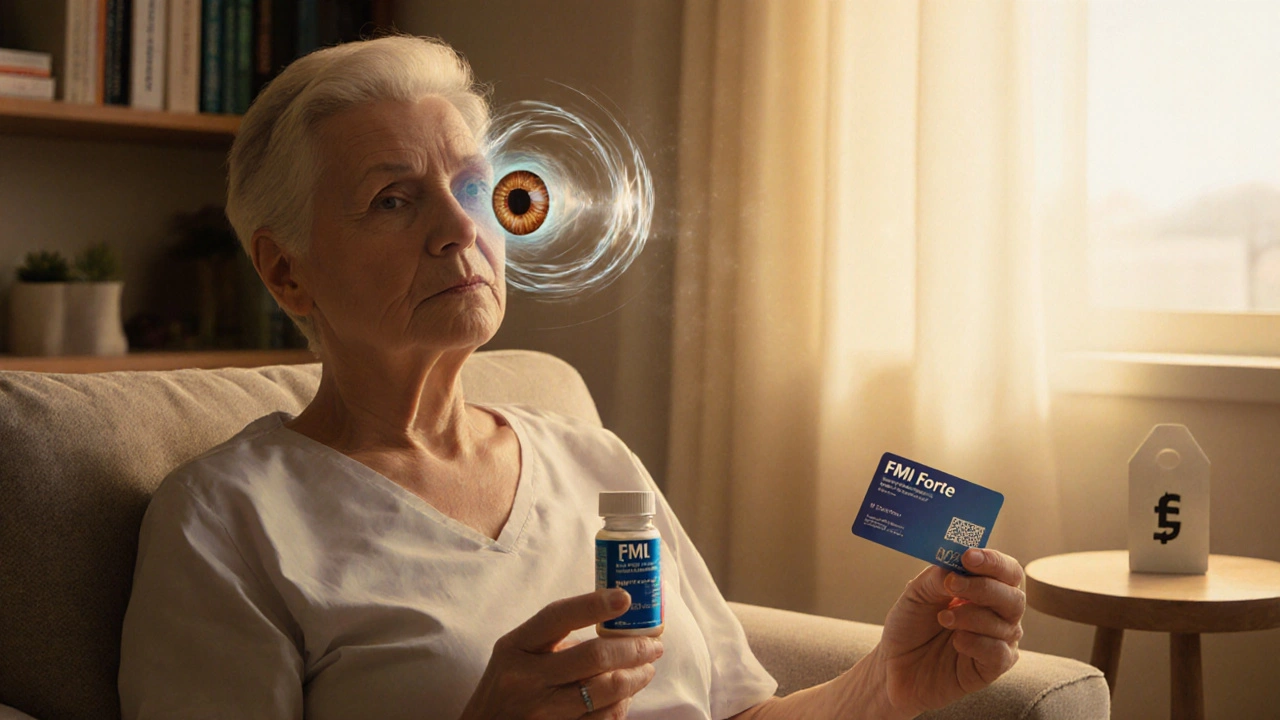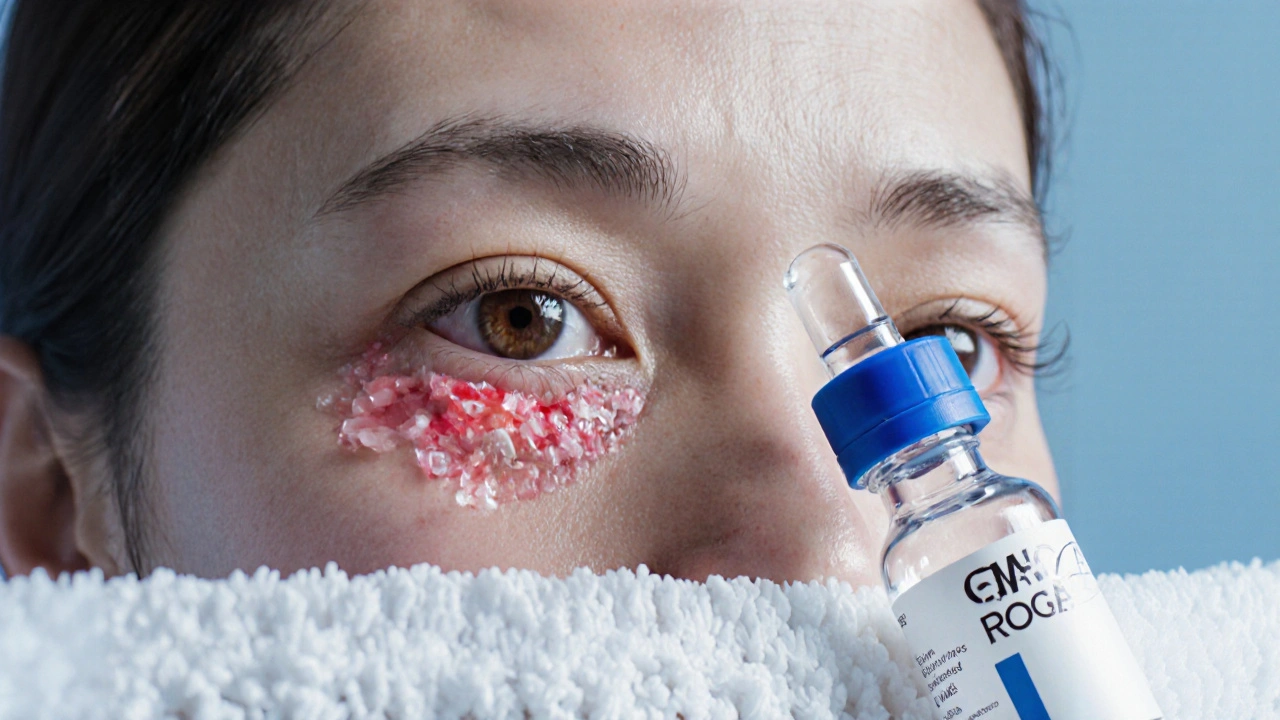When your eye feels inflamed after surgery or an allergic flare‑up, you’ll often be handed a bottle of Fluorometholone. But is it really the right choice, or could another eye steroid give you the same relief with fewer side effects? This guide breaks down FML Forte and the most common alternatives, so you can decide which drop fits your needs.
What Is Fluorometholone (FML Forte)?
Fluorometholone is a medium‑potency synthetic corticosteroid formulated as a 0.1% ophthalmic suspension, sold under the brand name FML Forte. It was first introduced in the 1970s and quickly became popular for postoperative inflammation, uveitis, and severe allergic conjunctivitis because it offers strong anti‑inflammatory action while sparing the eye’s natural barrier more than higher‑potency steroids.
Typical dosing is one drop four times daily for the first few days, then tapering over 1‑2weeks depending on the clinician’s assessment.
Key Criteria for Comparing Eye Steroids
- Potency: How powerful the drug is at reducing inflammation.
- Onset of Action: How quickly patients notice symptom relief.
- Risk of Increased Intra‑ocular Pressure (IOP): Steroids can raise eye pressure, leading to glaucoma if not monitored.
- Duration of Effect: How long a single drop remains active.
- Safety in Sensitive Situations: E.g., use after cataract surgery, in children, or in patients with a history of steroid‑responsive glaucoma.
- Cost & Availability: Price per bottle in Australian pharmacies and whether it’s covered by the PBS.
Top Alternatives to FML Forte
Below are the most frequently prescribed eye steroids that sit next to Fluorometholone on a doctor’s formulary.
Prednisolone acetate (brand Pred Forte) is a high‑potency corticosteroid available as a 1% suspension. It provides rapid inflammation control but carries a higher IOP‑rise risk.
Loteprednol etabonate (brand Lotemax) is a soft‑drug corticosteroid designed to break down quickly in ocular tissues, reducing IOP spikes while still offering strong anti‑inflammatory effects.
Dexamethasone (brand Dexasone) is a very high‑potency steroid often reserved for severe uveitis. Its powerful action comes with a notable risk of cataract formation and glaucoma.
Hydrocortisone (0.5% suspension) is a low‑potency steroid used for mild allergic conjunctivitis. It’s gentle on IOP but may be insufficient for postoperative inflammation.
Some clinicians also prescribe Non‑steroidal anti‑inflammatory eye drops (e.g., ketorolac) as adjuncts or alternatives when steroids are contraindicated.
Side‑Effect Profile Compared
| Drug | IOP Rise (Low/Mod/High) | Cataract Risk | Typical Indication |
|---|---|---|---|
| Fluorometholone | Low‑to‑moderate | Low | Post‑op inflammation, moderate uveitis |
| Prednisolone acetate | Moderate‑to‑high | Moderate | Severe postoperative, uveitis |
| Loteprednol etabonate | Low | Very low | Allergic conjunctivitis, mild post‑op |
| Dexamethasone | High | High | Severe uveitis, retinal inflammation |
| Hydrocortisone | Low | Negligible | Mild allergic reactions |
In practice, patients with a history of steroid‑responsive glaucoma are usually steered toward Loteprednol or even a low‑potency Hydrocortisone regimen. If rapid control is essential-say after cataract extraction-many surgeons start with Prednisolone acetate then taper to Fluorometholone to limit IOP exposure.
Cost and Accessibility in Australia (2025)
Price points can influence the final decision, especially for longer tapering courses.
- FML Forte (30drops): AU$12‑$15, PBS‑eligible for most concession card holders.
- Pred Forte (30drops): AU$20‑$25, generally not PBS‑listed.
- Lotemax (30drops): AU$30‑$35, higher due to soft‑drug technology.
- Dexamethasone (30drops): AU$22‑$27, occasional bulk discounts for hospitals.
- Hydrocortisone (30drops): AU$8‑$10, widely available over the counter.
For a typical 2‑week postoperative course, the total out‑of‑pocket cost for Fluorometholone often ends up lower than its high‑potency peers, making it a budget‑friendly option without sacrificing efficacy.

Bottom Line: When to Choose Fluorometholone
If you need a steroid that balances potency with a safer IOP profile, FML Forte sits in the sweet spot. It’s especially suitable for:
- Standard cataract or laser eye‑surgery recovery.
- Moderate anterior uveitis where a quick taper is desired.
- Patients with a mild‑to‑moderate history of steroid‑induced pressure spikes.
- Anyone looking for a PBS‑subsidised option.
Reserve higher‑potency agents like Pred Forte or Dexamethasone for cases where inflammation is aggressive or refractory. Opt for low‑potency Hydrocortisone or NSAID drops when the inflammation is mild or when steroids are contraindicated.
Key Takeaways
- Fluorometholone offers medium potency with a lower risk of IOP elevation compared to many high‑potency steroids.
- Loteprednol etabonate is the safest for pressure‑sensitive eyes but comes at a higher price.
- Prednisolone acetate delivers the strongest anti‑inflammatory punch but demands close IOP monitoring.
- Cost‑wise, FML Forte is often the most affordable PBS‑listed option in Australia.
- Choosing the right drop hinges on inflammation severity, glaucoma risk, and budget.
Frequently Asked Questions
Can I use Fluorometholone after LASIK?
Yes. Many ophthalmologists prescribe a short 5‑day course of FML Forte post‑LASIK to control mild inflammation. Because its IOP‑rise risk is low, it’s a safe choice for most patients.
What should I do if my eye pressure goes up while using eye steroids?
Stop the steroid immediately and contact your eye‑care professional. They may switch you to a low‑risk option like Loteprednol or add a pressure‑lowering eye drop. Regular IOP checks are standard during any steroid course lasting more than a week.
Is Fluorometholone safe for children?
It can be used in children, but dosage and duration are usually shorter. Pediatric eyes are more prone to steroid‑induced cataract, so doctors monitor IOP closely.
How does Fluorometholone compare to over‑the‑counter eye drops?
OTC drops (e.g., artificial tears or antihistamine drops) relieve dryness or mild itch but lack the anti‑inflammatory power of a steroid. If your doctor has prescribed FML Forte, it’s because the inflammation is beyond what OTC products can handle.
Can I use Fluorometholone with contact lenses?
It’s best to remove lenses before instilling the drop, wait a few minutes, then re‑insert. The suspension can coat lenses and reduce vision clarity.


Bernard Lingcod
October 13, 2025 AT 16:34Balancing inflammation control with IOP safety is key, especially after cataract surgery where you want a smooth recovery without extra glaucoma risk. Fluorometholone sits nicely in that middle ground, offering enough punch to calm the postoperative flare while keeping pressure spikes low for most patients. The PBS subsidy in Australia also makes it a cost‑effective option compared to many of the high‑potency counterparts. If you’re on the fence, think about the typical taper schedule and how that plays into your daily routine.
Raghav Suri
October 14, 2025 AT 12:00Look, the math is simple: you either go for the cheap, decent‑mid potency drug or you burn a hole in your wallet for a high‑potency steroid that screams IOP spikes. FML Forte gives you the sweet spot without the drama of Pred Forte’s pressure hikes. If you’ve got a history of steroid‑responsive glaucoma, ditch the high‑potency stuff and stick with Loteprednol or even Hydrocortisone.
Kelly Hale
October 15, 2025 AT 06:04From the moment I first laid eyes on the tables comparing Fluorometholone to its more aggressive cousins, I felt a surge of patriotic pride, for it is our Australian healthcare system that bravely offers a PBS‑subsidised medium‑potency steroid that does not betray its patients with the treacherous rise of intra‑ocular pressure that the foreign giants of high‑potency steroids so readily unleash.
It is a fact, as solid as the outback rock, that a medication like Fluorometholone, with its low‑to‑moderate IOP profile, respects the delicate balance of ocular physiology, unlike the merciless Prednisolone acetate, which, while powerful, often forces patients into an endless cycle of pressure monitoring.
The economic advantage cannot be ignored either; a thirty‑drop bottle costing merely a dozen dollars, subsidised for the common man, stands in stark contrast to the exorbitant price tags of Lotemax and Dexamethasone, which demand that the average Australian splurge extra hard‑earned dollars to obtain.
These price disparities are not mere numbers; they represent the very ethos of a healthcare system that chooses accessibility over profit, ensuring that even a modest household can afford proper postoperative care.
Moreover, the safety profile of Fluorometholone extends beyond IOP concerns; its lower cataract formation risk makes it an ideal candidate for long‑term users, especially the elderly who are already battling age‑related lens opacity.
When you consider the practicalities of post‑surgical regimens, the four‑times‑daily dosing that tapers over a couple weeks feels manageable, providing consistent therapeutic levels without overwhelming the patient.
Contrast this with the fierce potency of Dexamethasone, whose high‑risk cataract and glaucoma potential often requires a stop‑and‑go approach, interrupting the healing cascade and potentially prolonging visual recovery.
For children, the moderate nature of Fluorometholone translates into a gentler hand, demanding less invasive monitoring, which is a blessing for both the young patients and their anxious parents.
In addition, the flexibility to switch from a high‑potency steroid to Fluorometholone during the taper phase gives surgeons a strategic advantage: they can blunt the most aggressive inflammation early on and then hand over to a softer, safer agent for the maintenance phase.
All these facts converge into a single, undeniable conclusion: Fluorometholone embodies the ideal compromise, blending efficacy, safety, and affordability into one harmonious package that respects both the eye and the pocket.
So, when your ophthalmologist asks you to choose, remember that the true champion stands not in the most powerful chemical arsenal but in the balanced, patient‑centric approach that Fluorometholone provides.
Uju Okonkwo
October 15, 2025 AT 22:44For anyone feeling overwhelmed by the tables, think of Fluorometholone as the reliable teammate who consistently shows up for practice – not the flashiest player, but the one who keeps the team steady. If you’re managing a patient with mild‑to‑moderate pressure spikes, starting with FML Forte can prevent the need for extra medication later.
allen doroteo
October 16, 2025 AT 14:00i think u all over hype fml forte its not that great it can cause iop rise too and it is not cheaper than lotemax in some pharmacies i read some posts saying its the same as pred forte in effect but with less cost but that dont sounds right its all marketing
Corey Jost
October 17, 2025 AT 03:54While some might tout Fluorometholone as the perfect middle‑ground, a deeper dive reveals that the so‑called "sweet spot" is often a compromise that may not serve all clinical scenarios optimally; for instance, patients with aggressive postoperative inflammation could benefit more from the rapid, high‑potency action of Prednisolone acetate, despite its more demanding IOP monitoring schedule, because the speed of inflammation control can directly correlate with visual outcomes and patient comfort, something that a slower‑acting medium‑potency steroid might struggle to achieve without extending the overall treatment duration, thereby potentially increasing cumulative exposure and associated risks.
Nick Ward
October 17, 2025 AT 16:24That’s a solid point – the choice really hinges on the specific inflammation severity and the patient’s glaucoma history 😊. Glad we have options to tailor therapy.
felix rochas
October 18, 2025 AT 03:30Everyone’s being brain‑washed by pharma to sell you the most expensive steroid.
inder kahlon
October 18, 2025 AT 13:14It’s important to remember that the regulatory bodies in Australia actually review these subsidies, so the lower price isn’t just a marketing ploy; it reflects a genuine assessment of cost‑effectiveness for a drug that balances efficacy and safety well enough for most postoperative cases.
Dheeraj Mehta
October 18, 2025 AT 21:34Feeling hopeful that with the right drop you can get back to clear vision without the fear of pressure spikes! 🌟
Oliver Behr
October 19, 2025 AT 04:30Exactly – keep the focus on patient‑centred care rather than brand loyalty.
Tiffany W
October 19, 2025 AT 10:04The ethical imperative mandates that clinicians prioritize pharmacoeconomic stewardship, especially when the therapeutic index of Fluorometholone aligns with evidence‑based guidelines.
Rajeshwar N.
October 19, 2025 AT 14:14While the moral argument is compelling, the data still show that in high‑risk glaucoma patients, even low‑potency steroids can precipitate pressure elevations, so a blanket endorsement of Fluorometholone isn’t warranted without individualized risk assessment.